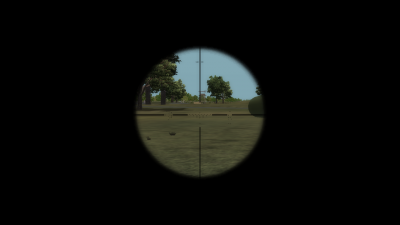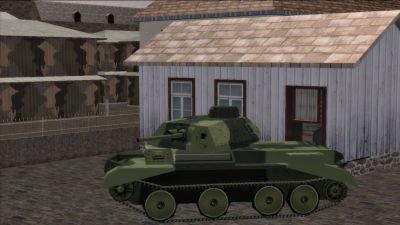Difference between revisions of "Cruiser"
(Created page with "=Cruiser Tank Mk IV (A13 Mk II)= =History= {| class="wikitable floatright" | colspan="2" | 400px |- style="background:#666600; color:#fff;" |...") |
|||
| (One intermediate revision by the same user not shown) | |||
| Line 21: | Line 21: | ||
{| class="wikitable floatright" | {| class="wikitable floatright" | ||
| colspan="2" | [[File:Optic | | colspan="2" | [[File:Cruiser Tank Mk IV A13 Optic.png|400px]] | ||
|- style="background:#666600; color:#fff;" | |- style="background:#666600; color:#fff;" | ||
| colspan="2" style="text-align: center;" | '''Main Gun Optics''' | | colspan="2" style="text-align: center;" | '''Main Gun Optics''' | ||
| Line 58: | Line 58: | ||
Drive the A13 like an armored car – pay close attention to your situation and don’t stand in a gunnery duel if you can avoid it. Don’t be afraid to stop and look around, as long as you’re in cover. When near enemy armor, move cautiously and slowly. See the enemy before he sees you. | Drive the A13 like an armored car – pay close attention to your situation and don’t stand in a gunnery duel if you can avoid it. Don’t be afraid to stop and look around, as long as you’re in cover. When near enemy armor, move cautiously and slowly. See the enemy before he sees you. | ||
Many players who aspire to be great tankers come to find the cruiser concept difficult to understand, but it really couldn’t be simpler. Tankers short of imagination will try to engage everything frontally; the A13 commander must learn he has to outsmart his opponent. Surprise the enemy, outsmart and outmaneuver him. Once he gets a high-velocity 2pdr round in his rear or side he won’t be making your life difficult at all. Instead, he’ll be cursing while his once mighty Panzer becomes a funeral pyre. | Many players who aspire to be great tankers come to find the cruiser concept difficult to understand, but it really couldn’t be simpler. Tankers short of imagination will try to engage everything frontally; the A13 commander must learn he has to outsmart his opponent. Surprise the enemy, outsmart and outmaneuver him. Once he gets a high-velocity 2pdr round in his rear or side he won’t be making your life difficult at all. Instead, he’ll be cursing while his once mighty Panzer becomes a funeral pyre. | ||
The A13 is available from tier 0. | |||
=Armor= | =Armor= | ||
Latest revision as of 10:06, 22 September 2020
Cruiser Tank Mk IV (A13 Mk II)
History

| |
| Main Gun Optics | |
| Specifications | |
| Designation | No. 33 Mk. IV S. |
| Magnification | 1.9x |
| Field of View | 21° |
The A13 was an immensely important step forward in British tank evolution, for it was the first British cruiser tank to incorporate a suspension system that stemmed from the designs developed by the American designer J. Walter Christie. His coil-spring suspension system was to be included in the design of all future British cruiser tanks. The most famous tank to incorporate this suspension system was the Soviet manufactured T-34, arguably the best all-round tank of the war.
The man responsible for the introduction of the Christie suspension into British vehicles was a Lt. Col. Martel, who was appointed Assistant Director of Mechanisation to the War Office in the late summer of 1936. That September, Martel attended Soviet Army training maneuvers where the Soviet BT tank suitably impressed him. The BT tank incorporated a Christie suspension and demonstrated good performance and speed. It was based upon the British “16-tonner” of 1929 and was available in large numbers. Upon his return to the War Office, Martel set out to instigate the design of a vehicle with vastly superior performance than had previously been seen in Britain. This was to be achieved primarily by adopting the Christie suspension along with a powerful lightweight engine.
The War Office ordered two Christie demonstration vehicles from the United States and upon their arrival found that the Christie suspension incorporated compression springs along with large-diameter rubber-rimmed road wheels. The combination allowed the vehicle to run at high speed either with or without tracks. British designers saw trackless running capability as an unnecessary complication and quickly decided to dispense with it. They also undertook to widen the vehicle so that they could fit a 2pdr cannon into a larger turret. At the end of 1936, the British decided to build two prototypes; Morris Commercial Cars was asked to undertake the initial design. The prototypes were designated A13E2 and A13E3 after the original Christie demonstrator vehicles had received the designation A13E1.
Nuffield Mechanisations and Aero, a subsidiary of Morris, was, at the time, licensed to manufacture a high-performance American-designed World War I aircraft engine called the Liberty. With the Liberty engine, the A13E2 prototype chassis in October 1937 attained a top speed of 35 mph (56 km/h). Certain mechanical problems, due mainly to the high speed of the vehicle, were soon overcome. Designers added a governor to restrict the speed of the vehicle to 30 mph (48 km/h), altered the clutch and transmission, and added shorter, pitched tracks. In early 1938, the War Office awarded Nuffield a production order for 65 vehicles. Deliveries to the army began in early 1939 and by September of that year, all 65 had been delivered. These vehicles were officially known as Cruiser Tank Mark III (A13 Mk I).
In early 1939, the War Office had decided to increase the armor thickness of all British cruiser tanks to a standard 30 mm (1.18 in). One Cruiser Tank Mark III was modified to these specifications as a pilot model. Extra armor plate was placed upon the nose, glacis, and turret. Two additional armor plates reinforced each turret wall, configured so that one plate sloped out and down from the turret’s top edge while a second attached to the bottom edge sloped out and up. The two plates met and with the original turret wall enclosed a triangular hollow that gave the turret a distinctive angled look. German designers would later use this spaced armor effect to defeat hollow-charge projectiles such as the PIAT and Bazooka infantry anti-tank weapons.
Amazingly, testing showed that the weight of the extra armor did not appreciably degrade the tank’s performance, and all Mark IIIs were so modified. These vehicles, officially designated Cruiser Tank Mark IV (A13 Mk II), were used almost exclusively by the 1st Armored Division in France the following year.
Nuffield undertook main production of Cruiser Tank Mark IVs. The Cruiser Tank Mark IVA (A13 Mk II) was a later production vehicle with a coaxial Besa machine gun in place of the original Vickers. These vehicles were also used by 1st Armored Division in France, where they took part in the Allied counterattacks against the Somme River bridgeheads, May 23-24, 1940. Falling back with the rest of the BEF, they fought to defend Calais and Dunkirk. A13s were also issued to 7th Armored Division during the North Africa campaign.
British doctrine proposed that the cruiser-tank force would comprise fast anti-tank vehicles that would engage enemy armor while the more heavily armored infantry tanks would attract and absorb anti-tank return fire as they advanced slowly with the infantry. This concept was abandoned when combat experience showed that modern armor was deployed as demonstrated by the Germans and Russians in fluid, fast battles. The lightly armored cruiser tanks could not withstand fire from virtually any anti-tank guns, even the small ones in use early in the war. Total production of the Cruiser Tank Mk IV series amounted to some 655 examples but production ceased in 1941 as it became apparent that the vehicle was totally outclassed by the heavier and more powerful German tanks.
Game Play
The Cruiser Mk IV is an excellent light tank when not going toe-to-toe with enemy tanks. Its armor is just not thick enough for that. It does have a gun capable of killing most if not all the medium tanks it will face. The combination of its green color and fairly lethal gun make it excellent in ambush, which is the way the A13 should always be employed. It is fast enough to outflank an enemy force and take up an ambush position, but not thick enough to withstand hits.
The Cruiser suffers from mediocre gunsight optics. Practice on the tank range offline to train your eye and improve your ability to hit your target with the first shot, particularly at longer ranges. This is the greatest skill any tanker can learn. If you warn your enemy and reveal your position with a missed shot, they will find you quickly and penetrate your thin armor.
Drive the A13 like an armored car – pay close attention to your situation and don’t stand in a gunnery duel if you can avoid it. Don’t be afraid to stop and look around, as long as you’re in cover. When near enemy armor, move cautiously and slowly. See the enemy before he sees you.
Many players who aspire to be great tankers come to find the cruiser concept difficult to understand, but it really couldn’t be simpler. Tankers short of imagination will try to engage everything frontally; the A13 commander must learn he has to outsmart his opponent. Surprise the enemy, outsmart and outmaneuver him. Once he gets a high-velocity 2pdr round in his rear or side he won’t be making your life difficult at all. Instead, he’ll be cursing while his once mighty Panzer becomes a funeral pyre.
The A13 is available from tier 0.
Armor
| Location | Thickness | Angle |
|---|---|---|
| Hull front | 14 mm 30 mm |
60° 0° |
| Hull sides | 14 mm | 0° |
| Hull rear | x mm | y° |
| Hull top | 6 mm | 90° |
| Superstructure front | 14 mm 14 mm |
60° 0° |
| Superstructure sides | x mm | y° |
| Superstructure rear | 14 mm | 0° |
| Superstructure top | 14 mm | 90° |
| Turret front | 30 mm 30 mm |
11° 7° |
| Turret sides | 14 mm 14 mm |
38° 16° |
| Turret rear | 14 mm 14 mm |
38° 16° |
| Turret top | 14 mm 14 mm |
90° 80° |
| Gun mantlet | x mm | y° |
